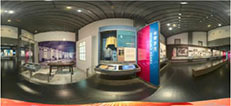Appendix Table 1 .
Panoramic video content and illustrations, questions with embedding and elaborated feedback.
| Panoramic video content and illustrations | Questions with embedding | Elaborated feedback |
Introduces the geographic location of Deng Xiaoping’s former residence, the main events of Deng Xiaoping’s childhood and adolescence.
|
1. Where is Deng Xiaoping’s former residence located? A Yilong County, Nanchong B Shunqing District, Nanchong C Xiexing Township, Guang’an City D Guang’an City Central District 2. Is Deng Xiaoping’s former residence just the place where Xiaoping lived as a child? ① Yes ② No |
1. True/False, Deng Xiaoping’s former residence is located in Xiexing Town, Guang’an City 2. True/False, Deng Xiaoping’s former residence is the place where he lived as a child and teenager |
Introducing Comrade Deng Xiaoping’s famous quotes, major events in his youth after leaving Guang’an, including when he studied abroad, when he returned to China, and when he became Secretary General of the Central Committee of the Communist Party of China (CPC).
|
1. Deng Xiaoping took his Russian name while studying at Sun Yat-sen University in Moscow? A Dodorov B Lovoo C Blinsky D Darski 2. Chiang Kai-shek staged a counter-revolutionary coup d’état in Shanghai. In December of the same year, Deng Xiaoping traveled to Shanghai and became the secretary of the Central Committee of the Communist Party of China. ① Yes ② No |
1. True/False, Deng Xiaoping’s Russian name was Dozorov when he studied at Sun Yat-sen University in Moscow 2. True/False, Chiang Kai-shek staged a counter-revolutionary coup in Shanghai. In July of the same year, Deng Xiaoping traveled to Wuhan as secretary of the CPC Central Committee, and in December, he traveled to Shanghai as secretary general of the CPC Central Committee |
Introduces Deng Xiaoping’s major deeds for the establishment of a new China and the realization of the independence and liberation of the Chinese nation, including the uprisings he led or initiated, the founding of the Workers’ and Peasants’ Red Army, the Zunyi Conference, as well as the major deeds during the War of Resistance Against Japanese Aggression and the War of Liberation.
|
1. Deng Xiaoping was dismissed by the “left” leaders during his stay in the Left and Right River bases? ① Yes ② No 2. During the Liberation War, Deng Xiaoping and Liu Bocheng led their troops into the Dabie Mountains. ① Yes ② No |
1. True/False, Deng Xiaoping was removed from his post by “left” leaders in the central base in Jiangxi because of his support for Mao Zedong’s correct line. 2. True/False, during the Liberation War, Deng Xiaoping and Liu Bocheng led an advance into the Dabie Mountains. |
Introducing Deng Xiaoping’s main deeds after the country’s liberation and before the Cultural Revolution.
|
1. In March 1973, the Party Central Committee reinstated Deng Xiaoping to the position of? A premier of the State Council B Vice Premier of the State Council (PRC) C secretary-general of the Communist Party of China Central Committee D Chairman of the Military Commission (PRC) 2. Did Deng Xiaoping lose all his positions twice after the start of the Cultural Revolution in 1966? ① Yes ② No |
1. True/False, Deng Xiaoping was removed from all his posts in the 1966 Cultural Revolution; in 1973, the Party Central Committee reinstated Deng Xiaoping as Vice Premier of the State Council 2. True/False, in 1966, Deng Xiaoping was removed from his post for the first time; in 1976, Deng Xiaoping was removed from his post for the second time |
Introduction to the background and significance of the formation of Deng Xiaoping Theory and its contribution to the country’s reform and opening up, and the content and significance of the Basic Line at the Primary Stage of Socialism.
|
1. Which of the following ideas about Deng Xiaoping is not mentioned in the material? A Emancipate your mind and seek truth from facts B the four basic principles C The “three-step” strategy D One China, Two Systems 2. The Fifteenth Party Congress summarized the theory of building socialism with Chinese characteristics as Deng Xiaoping Theory, which was written into the Party Constitution as the Party’s guide to action. ① Yes ② No |
1. True/False, the four basic principles are not mentioned in the materials 2. True/False, the 15th Party Congress summarized the theory of building socialism with Chinese characteristics as Deng Xiaoping Theory, which was written into the Party Constitution as the Party’s guide to action. |
